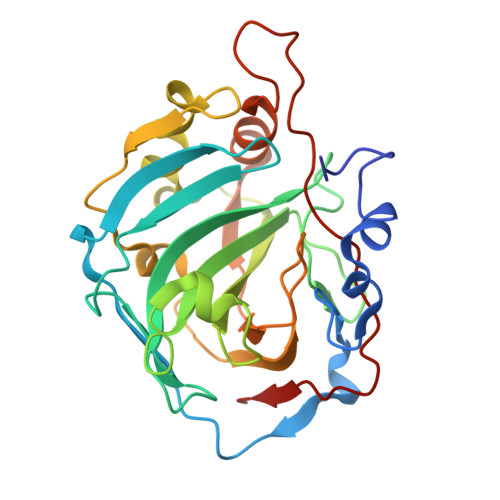A new framework for novel analogues of pazopanib as potent and selective human carbonic anhydrase inhibitors: Design, repurposing rational, synthesis, crystallographic, in vivo and in vitro biological assessments.
Hefny, S.M., El-Moselhy, T.F., El-Din, N., Ammara, A., Angeli, A., Ferraroni, M., El-Dessouki, A.M., Shaldam, M.A., Yahya, G., Al-Karmalawy, A.A., Supuran, C.T., Tawfik, H.O.(2024) Eur J Med Chem 274: 116527-116527
- PubMed: 38810335
- DOI: https://doi.org/10.1016/j.ejmech.2024.116527
- Primary Citation of Related Structures:
8QUN - PubMed Abstract:
Herein, we describe the design and synthesis of novel aryl pyrimidine benzenesulfonamides APBSs 5a-n, 6a-c, 7a-b, and 8 as pazopanib analogues to explore new potent and selective inhibitors for the CA IX. All APBSs were examined in vitro for their promising inhibition activity against a small panel of hCAs (isoforms I, II, IX, and XII). The X-ray crystal structure of CA I in adduct with a representative APBS analogue was solved. APBS-5m, endowed with the best hCA IX inhibitory efficacy and selectivity, was evaluated for antiproliferative activity against a small panel of different cancer cell lines, SK-MEL-173, MDA-MB-231, A549, HCT-116, and HeLa, and it demonstrated one-digit IC 50 values range from 2.93 μM (MDA-MB-231) to 5.86 μM (A549). Furthermore, compound APBS-5m was evaluated for its influence on hypoxia-inducible factor (HIF-1α) production, apoptosis induction, and colony formation in MDA-MB-231 cancer cells. The in vivo efficacy of APBS-5m as an antitumor agent was additionally investigated in an animal model of Solid Ehrlich Carcinoma (SEC). In order to offer perceptions into the conveyed hCA IX inhibitory efficacy and selectivity in silico, a molecular docking investigation was also carried out.
- Department of Pharmaceutical Chemistry, Faculty of Pharmacy, Tanta University, Tanta, 31527, Egypt. Electronic address: salma.mosaad@pharm.tanta.edu.eg.
Organizational Affiliation:




















